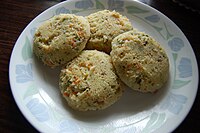Bombay rava

Bombay rava or ravva or rawa or sooji, is a durum wheat product and a form of semolina. Rava is made by grinding husked wheat and is used in Indian cuisine to make savoury dishes such as rava dosa, rava idli, upma, khichdis. There are also sweet dishes made from it, take for example rava ladoo, and sooji halwa in North Indian cuisine which is also known as rava kesari/ kesari bath in South Indian cuisine.[1][2]
There is another type of semolina (rava) known as chamba rava, which is a byproduct obtained while milling for wheat flour, Bombay rava is actually made of maida, and hence it is finer.[3]
Process[edit | edit source]
Rava may be described as the residues of milled material, after the flour is ground in a flour mill (chakki). It is passed through a fine mesh till flour and rava are separated.
Usage[edit | edit source]
Bombay rava is used in India to make upma. It is also used as an ingredient in some varieties of dosa, especially the rava dosa.[3]
References[edit | edit source]
- ↑ Ravva kesari / Sheera Archived January 6, 2011, at the Wayback Machine
- ↑ "Rava Ladoo recipe". Archived from the original on 14 June 2009. Retrieved 28 July 2009.
- ↑ 3.0 3.1 "Rava Dosa Recipe". Archived from the original on 15 July 2011. Retrieved 28 July 2009.